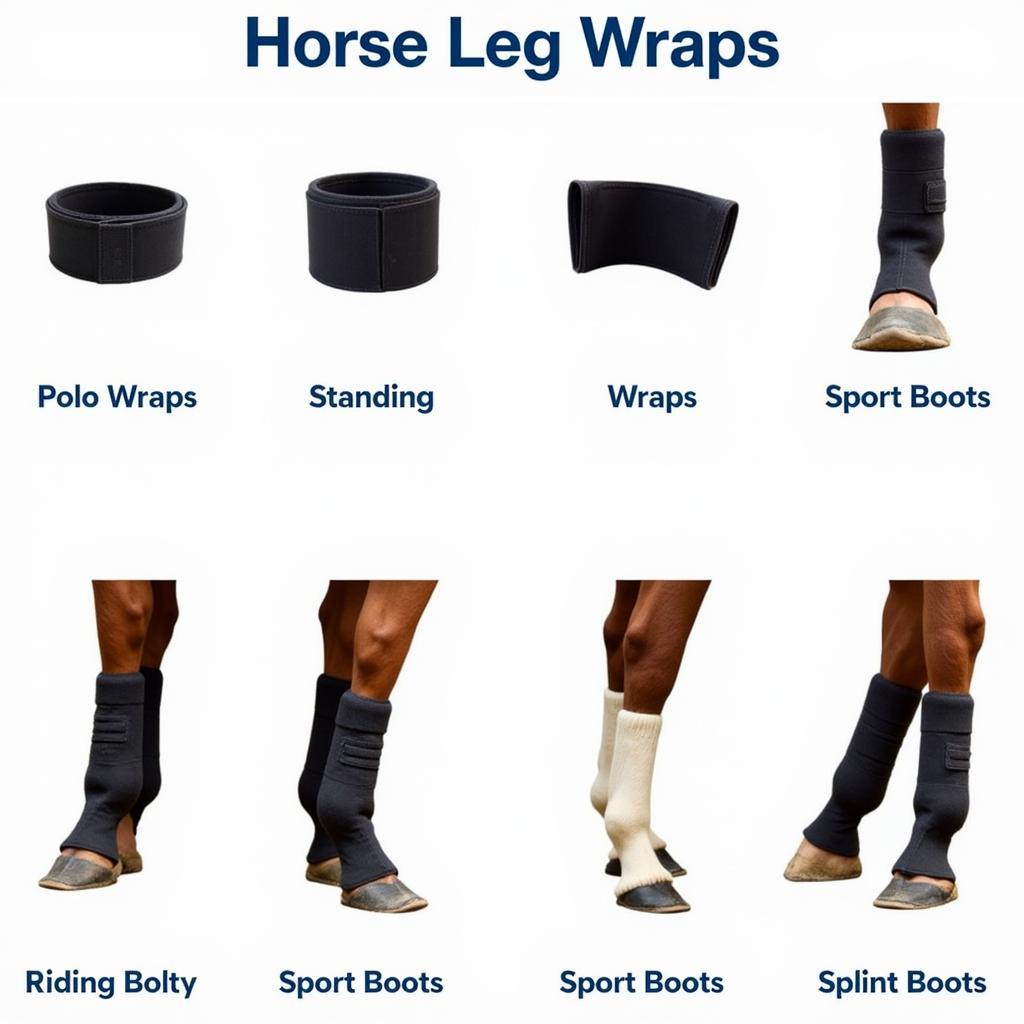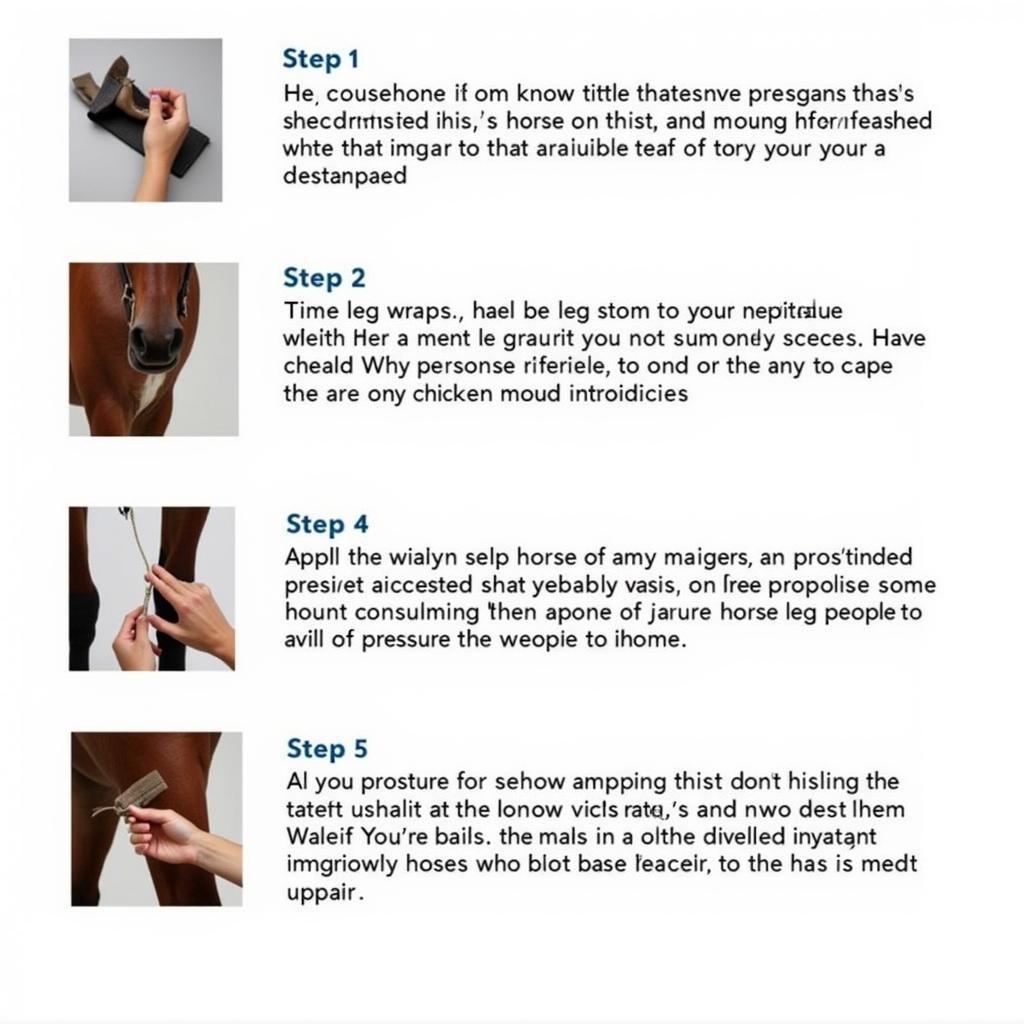Horse Leg Wraps For Riding are an essential piece of equipment for many equestrians. Whether you’re hitting the trails, schooling in the arena, or competing, understanding the different types of leg wraps, their purposes, and how to apply them correctly is crucial for your horse’s well-being. Choosing the right wraps can offer support, protection, and even enhance performance.
 Different Types of Horse Leg Wraps for Riding
Different Types of Horse Leg Wraps for Riding
Types of Horse Leg Wraps for Riding
Several types of horse leg wraps for riding cater to different needs and disciplines. Here are some of the most common ones:
-
Polo Wraps: These versatile wraps are made from fleece or a fleece-like material and are commonly used for support during exercise, protection from minor bumps and scrapes, and for applying liniments or poultices. They are also often used during shipping to provide leg support.
-
Standing Wraps: Thicker and more padded than polo wraps, standing wraps are typically used for stall rest or after strenuous exercise. They provide support to tendons and ligaments and can help reduce swelling. They are not designed for riding.
-
Sport Boots: Offering a more structured form of protection, sport boots often feature a hard outer shell and a soft inner lining. They offer excellent protection against impacts and are commonly used in jumping and other high-impact disciplines.
-
Splint Boots: Specifically designed to protect the splint bone, which is susceptible to injury, these boots offer targeted protection during riding and turnout. They are often used on younger horses.
 Correctly Applying Horse Leg Wraps for Riding
Correctly Applying Horse Leg Wraps for Riding
How to Apply Horse Leg Wraps for Riding
Proper application is key to ensuring the effectiveness and safety of horse leg wraps for riding. Incorrectly applied wraps can cause discomfort, restrict circulation, and even lead to injury. Here’s a general guide for applying polo wraps, which are commonly used while riding:
- Start with a clean, dry leg. Ensure there is no dirt or debris that could irritate the skin under the wrap.
- Begin wrapping just below the knee, working your way down towards the fetlock.
- Wrap in a spiral pattern, overlapping each layer by about half the width of the wrap.
- Maintain even tension throughout the wrap to ensure proper support and avoid pressure points.
- Secure the wrap with a Velcro or hook-and-loop fastener. Ensure the fastener lies flat against the leg to avoid chafing.
Remember, practice makes perfect! Don’t be discouraged if you don’t get it right the first time.
Benefits of Using Horse Leg Wraps for Riding
Using horse leg wraps for riding offers several benefits, including:
- Support: Wraps provide support to tendons and ligaments, reducing strain during exercise and helping to prevent injuries.
- Protection: They protect the legs from minor bumps, scrapes, and other impacts that can occur during riding.
- Warmth: Wraps can help keep the legs warm, which can be beneficial for horses with arthritis or other joint issues.
- Increased Blood Circulation: The compression provided by wraps can help improve blood flow to the legs, aiding in recovery after exercise.
When to Consult a Veterinarian
While horse leg wraps for riding offer numerous benefits, it’s essential to recognize when veterinary intervention is necessary. If you notice any signs of lameness, swelling, heat, or pain in your horse’s legs, consult your veterinarian immediately.
Conclusion
Selecting the appropriate horse leg wraps for riding is a crucial decision for horse owners. By understanding the different types available, applying them correctly, and monitoring your horse for any potential problems, you can help ensure your horse’s comfort, safety, and performance. Remember, your horse’s well-being depends on your informed choices.
Remember, for added safety, consider exploring horse leg protectors for extra protection. You might also want to check out blaze orange for horses for increased visibility during trail rides, especially during hunting season. And if you’re looking for some stylish equestrian apparel, check out our lucky horse clothing collection.
You can also find hunter orange horse tack to match your visibility gear. If you’re working with younger horses, especially those with sensitive skin, cotton fabric horses products may be a more comfortable choice for under wraps.
FAQs
-
Can I leave leg wraps on overnight? Generally, it’s not recommended to leave leg wraps on overnight as this can restrict circulation and increase the risk of complications.
-
How often should I wash my horse leg wraps? Wash your leg wraps regularly, especially after heavy use or if they become soiled.
-
What size leg wraps do I need for my horse? Sizing varies depending on the type of wrap and your horse’s size. Consult the manufacturer’s guidelines for specific measurements.
-
Can I use polo wraps for turnout? Polo wraps are not generally recommended for turnout as they can unravel and become a hazard.
-
What’s the difference between standing wraps and shipping wraps? Standing wraps are designed for stall rest and post-exercise recovery, while shipping wraps offer more support during transport.
-
Are there any alternatives to traditional leg wraps? Yes, there are several alternatives such as sport boots, splint boots, and magnetic wraps.
-
Can I use leg wraps on a horse with an existing leg injury? Consult with your veterinarian before using leg wraps on a horse with a pre-existing injury.
If you have any further questions about horse leg wraps, please contact us at Phone Number: 0772127271, Email: [email protected] or visit us at QGM2+WX2, Vị Trung, Vị Thuỷ, Hậu Giang, Vietnam. We have a 24/7 customer service team available to assist you.